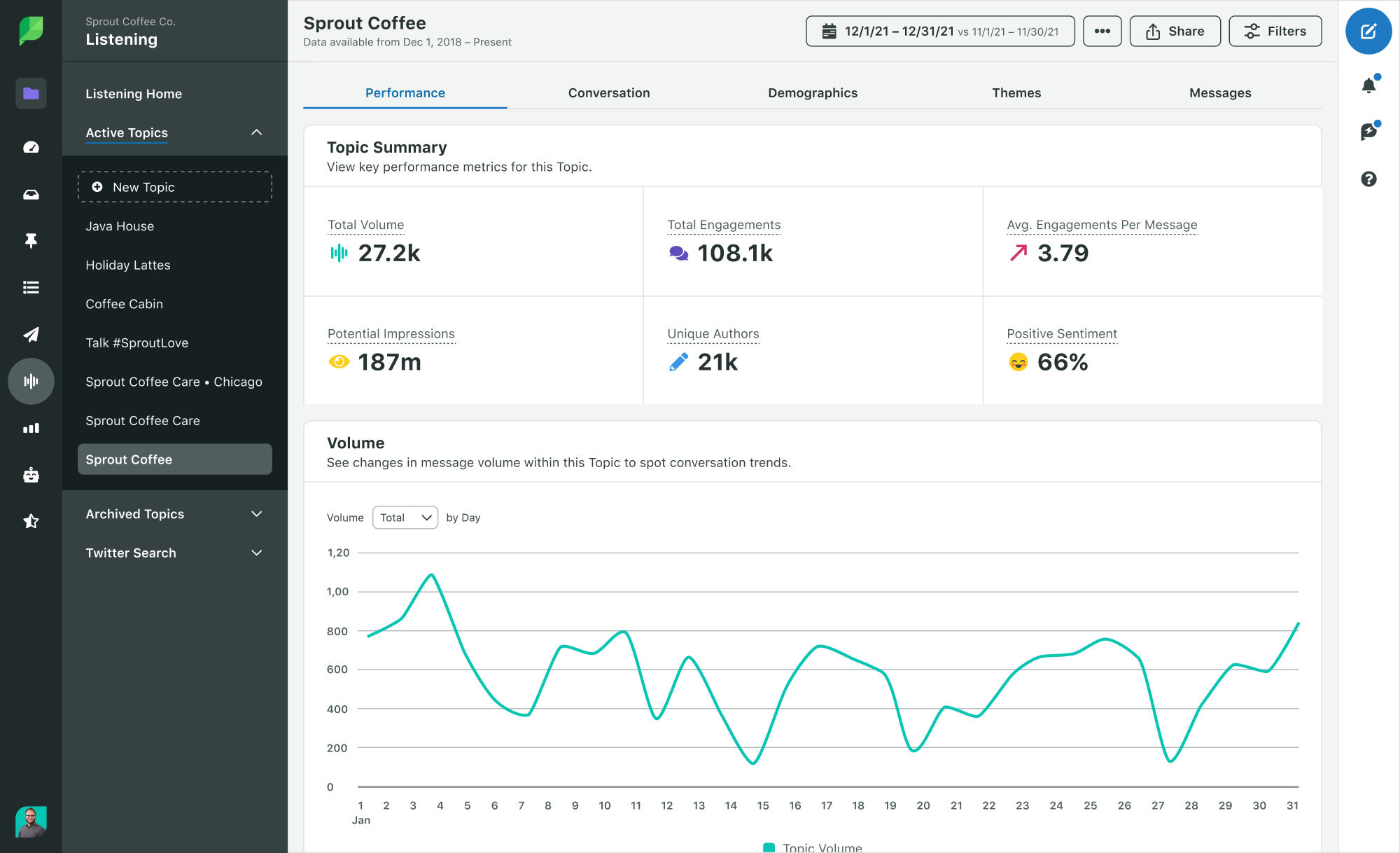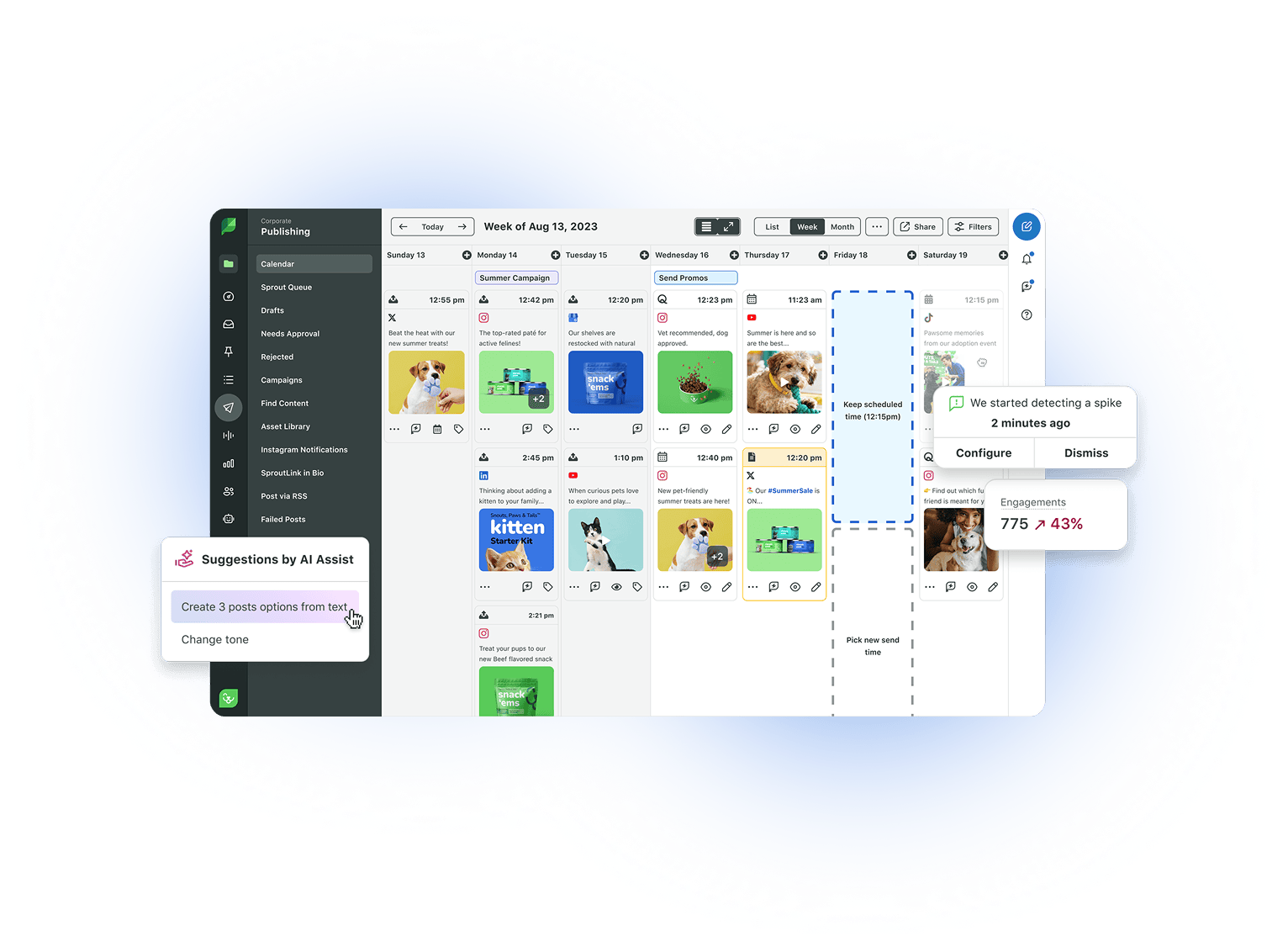Why your entire team needs access to social business intelligence

Table of Contents
After a year of transformation, businesses are going all-in on social—90% of executives see social becoming the primary communication channel for connecting with customers, according to recent findings in the Harris Poll on behalf of Sprout Social. Business leaders don’t just see social as a communication tool though, they see it as a valuable source for business intelligence. In fact, 85% report that going forward, social will be a primary source of data to inform business decisions.
The unbiased consumer, industry and competitor insights gleaned from social can be influential far beyond the marketing department. Social is the first place consumers turn to when they need information, entertainment or an outlet to voice their thoughts and opinions. It’s a place they go daily to engage with their favorite brands, provide feedback and learn about new products and services. Social moves fast, which is one of its strengths as a marketing business intelligence channel. However, that also means that customer sentiment, brand perception and cultural trends can change in a matter of minutes. Getting the most value from social business intelligence starts with the ability to access and act on it quickly.
We’ll take a deep dive in the article, but watch the video below for a five-minute break down of social business intelligence and how to use it, along with brand examples to help visualize how to use the data for your brand.
Speeding up time to social insights
Historically, business leaders might have only reviewed social data retrospectively to gauge performance and progress to goals. Now, we’ve entered a new era of social media management where that data can and should be used to drive proactive-decision making.
For instance, you might find that social content focused on an older product still consistently drives engagement, link clicks and website traffic. Your product team might use that data to upgrade the product in question or inspire a new product to the delight of your fans.

Or perhaps, a wave of customers suddenly begin seeking support through your social channels with concerns about a service outage, product flaw or website error. Based on those messages, your communications team can publish a statement while product or IT teams investigate. At the same time, customer service representatives can coordinate a support plan, monitor the situation and update customers as your business works toward a solution.

In both scenarios, the resulting qualitative and quantitative social data can also help your business reflect on the situation, assess the impact and apply learnings in the future.
Sprout Social’s Analytics give businesses the power to harness real-time and retrospective social business intelligence with ease.
In our Analytics Reports home, Sprout users can access social media performance across channels, from a network-level perspective all the way down to individual post performance. The intuitive interface makes it easy to navigate to the key performance indicators (KPIs) and metrics that matter most to your business.

Sprout eliminates time-consuming tasks from the reporting process, so you can digest, apply and share data faster. No scrubbing data, manual calculations, clunky spreadsheets or busy dashboards necessary. In minutes, Sprout users can customize, annotate, export and share presentation-ready reports among stakeholders.

Democratizing social listening data
As more businesses embrace social data as a business intelligence source, social professionals must be trusted and empowered to share their insights. But moving forward, extracting value from social should be something anyone across a business can do. To truly make social a part of business transformation, brands must democratize social data.
Marketing departments are already challenged by a lack of technology adoption, often because their tools are cumbersome or prohibitive to users who aren’t deep analytics experts. Marketers only use 58% of their existing technology capabilities, according to Gartner research. To get that percentage up, most businesses would need to dedicate more time and resources to team upskilling.
Sprout Social is intuitive enough for anyone to use, without a significant investment in technical training.
Social listening, in particular, enables anyone to zoom out beyond owned data and tap into larger social conversations that are rich with industry, competitor and audience insights. Sprout’s social listening tool plugs brands into that power source and immediately surfaces data that can supercharge your business. Create highly customizable Topics that cut through the noise and help your business:
- Gauge consumer perception and sentiment around your brand
- Identify gaps in your industry that your brand is equipped to fill
- Discover opportunities to differentiate your brand from the competition
- Uncover inspiration for product innovation
- Collect voice of the customer (VoC) data to improve the overall customer experience

The user-friendly experience and digestible format make it so that a diverse set of stakeholders—marketers, customer service representatives, product developers, executive leadership and more—can all distill actionable insights from social listening data, without having a data science background.
At Sprout, employees outside of the marketing team are empowered to use listening data. Our sales representatives often create listening reports around timely events, and use the takeaways in their sales process. Listening also helped Sprout’s cross-functional tiger team reevaluate our business plan and hone in on what our customers needed most during the pandemic.
Using social listening to drive business growth
Sprout customers have used listening to answer questions like, what day is leg day? What should be the focus for the next season of our podcast? Who was the artist of the summer? And that’s just the tip of the iceberg.
Sprout’s Social Listening tool made it clear to Trek Bicycle that 2020 was the year of the bike boom. And with the bike boom came a surge in the brand’s audience. New cyclists and riders that hadn’t expressed interest in biking were suddenly vocal biking enthusiasts.

To better understand these “bike boom riders” and what they’re looking to get from cycling, the biking brand leveraged Sprout’s Advanced Listening solution. Not only did the listening data help inform their social strategy, but it also influenced the brand’s overall business strategy as well. It helped the brand forecast how long this bike boom might last and how they could capitalize on it.

Unlock social business intelligence for all
Between insights derived from direct communication with your customers, content performance analytics and social listening data that gives your brand a clearer view of the culture at large, it’s not hard to understand why businesses are all-in on social. The intelligence you can garner from social media doesn’t just make a brand, it grows a business.
Don’t risk your business being left behind in the next wave of digital transformation—harness the power of social business intelligence with the help of Sprout Social. Request a free demo to try out our Social Listening tool.



Share